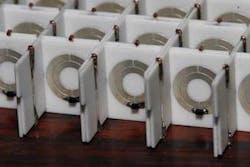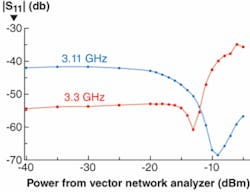A research team at the Nonlinear Physics Centre of the Australian National University in Canberra, (see www.rsphysse.anu.edu.au/nonlinear) reports that it has produced the first nonlinear tunable metamaterial and, using the metamaterial, has demonstrated several novel effects.1 The team focused on nonlinear materials—in which the frequency or intensity of electromagnetic waves change the properties of the material, leading to a mutual interaction—and microwave frequencies between 3.11 and 3.27 GHz, at which the material becomes “left-handed” (that is, with negative refractive index). The material ceases being left-handed at other frequencies.
The researchers first carried out experiments on the free-space scattering properties of a microwave metamaterial created by layers of printed-circuit boards with split-ring resonators (SRRs) and wires arranged to form a superlattice. The group studied transmission and reflection of electromagnetic waves from a regular structure with varying spacing between the layers. The boards were then arranged in different superlattice configurations and the dual-resonance behavior of the metamaterial was analyzed. The team found that by varying the periodicity in one dimension, the reflection and transmission resonances could be shifted by more than 15% of the resonance frequency.
The first step in the creation of tunable nonlinear metamaterials was to study the dynamic tunability of the magnetic resonance of a single nonlinear split-ring resonator (SRR). The team demonstrated fabrication of SRRs by placing a varactor diode within the gap of the resonator. The diode allowed the SRR to be tuned by an applied DC voltage or by a high-power signal.2 Tunable nonlinear metamaterials were then made by placing a varactor in each of the SRRs of the superlattice structure. Different tuning regimes were demonstrated, with and without an inductive coil in parallel with the varactor. The coil changed the sign of the nonlinearity and eliminated the memory effect caused by charge accumulation across the varactor.
Tuned by varying amplitude
Next, the researchers studied the properties of the three-dimensional nonlinear tunable metamaterial fabricated by introducing varactor diodes in each SRR element of the composite structure, such that the whole structure becomes dynamically tunable by varying the amplitude of the propagating electromagnetic waves (see Fig. 1). The team measured a pronounced shift of the resonance itself and then measured the transmission through the nonlinear metamaterial with wires and SRRs for different power levels. When the frequency was at the left edge of the resonance, an enhanced transparency of the metamaterial was observed. However, when the power was increased, the frequency was shifted to the region of positive susceptibility and the material became opaque. As a result, strong suppression of the beam transmission (by almost 30 dB) was observed, in qualitative agreement with the group’s earlier theoretical predictions (see Fig. 2 and www.rsphysse.anu.edu.au/admin/php/highlights/ilya).Ilya Shadrivov, a member of the team, said that in the large-scale lattices used in the team’s work, the diodes substitute for the individual atoms in a material such as, for instance, glass. The atoms function as a tiny row of electrical dipoles interacting with the passing waves. The diodes serve the same purpose.
“If we use variable capacitance diodes on wire loops whose electrical properties change with field strength, we can induce nonlinear behavior,” he said. “The use of these large-scale diode arrays gives us the flexibility we need to test and further develop our models, yet on a scale easily constructed by humans. The microwaves are of longer wavelength and the lattice is bigger, but the physics and mathematics are exactly the same as for visible light,” he said.
One of the possible applications of tunable metamaterials is in “secret” communications—the coil absorbs the frequencies used in a communications system, said Shadrivov, making it impossible for outsiders to listen in.
The head of the Nonlinear Physics Center, Prof Yuri Kivshar, who initiated the first studies of metamaterials in Australia several years ago and put forward the novel concept of nonlinear tunable metamaterials, outlined some of the novel properties of left-handed metamaterials his group has revealed. In particular, a few years ago the group predicted theoretically that a one-dimensional periodic structure containing layers made of a left-handed metamaterial can trap light in three dimensions due to the existence of a complete photonic bandgap.3 “This is in sharp contrast with the fundamental concepts of the conventional physics of photonic crystals where complex structures with two- or three-dimensional periodicity are required,” Kivshar said.
Kivshar believes those findings point to future applications of metamaterials for microwaves, terahertz frequencies, and visible light as fabrication technologies become available. In particular, using the properties of nonlinear metamaterials the team aims to demonstrate experimentally the tunable cloaking effect that would allow at-will control of an object’s visibility.
REFERENCES
1. I.V. Shadrivov, Appl. Phys. Lett. 90, 201919 (2007).
2. D.A. Powell, I.V. Shadrivov, Yu S Kivshar, M V Gorkunov, Appl. Phys. Lett. 91, 144107 (2007).
3. I.V. Shadrivov, A.A. Sukhorukov, and Yu.S. Kivshar, Phys. Rev. Lett. 95, 193903 (2005).

